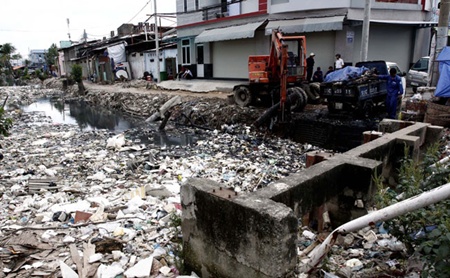In Vietnam, management of wildlife diseases has garnered attention from both the State and the public. This is evident through a comprehensive system of regulations addressing diseases that can be transmitted from wildlife to humans spanning a range of documents, from laws to decrees and circulars. However, despite these efforts, the practical implementation of wildlife disease management still encounters numerous challenges and shortcomings.

Environment law lifts green ethos
Deputy Minister for Natural Resources and Environment Bui Cach Tuyen has urged that environmental planning must be part of the country’s plans for socio-economic development.
Speaking at a conference earlier this month on a revision to the Law of Environmental Protection (2005), the Minister said the focus would create a better foundation for the implementation of environmental protection measures.
“This is a key measure to better the legal framework for environmental protection,” he said.
 Tonnes of litter left on the Tan Hoa – Lo Gom canal through Hoa Binh Street in HCM CIty’s Tan Phu District. Environmental planning must be part of the country’s plans for socio-economic. — VNA/VNS Photo Hoang Hai
Tonnes of litter left on the Tan Hoa – Lo Gom canal through Hoa Binh Street in HCM CIty’s Tan Phu District. Environmental planning must be part of the country’s plans for socio-economic. — VNA/VNS Photo Hoang Hai
In an effort to encourage greater commitment to environmental protection, the deputy minister stressed the need for strategic environment assessment (SEA) and environmental impact assessment (EIA) for major project.
Tuyen also said the responsibilities of households, producers and service providers in trade villages and local authorities would be clarified.
Vice Chairman of the National Assembly Committee for Sciences, Technology and Environment Vo Tuan Nhan said current regulations on environmental protection struggled with overlapping management, a lack of co-ordination between relevant agencies and increasing environmental violations.
He expected that the revision of the 8-year-old law on Environmental Protection, including measures such as SEA and EIA, would address the limitations.
Deputy President of the Viet Nam Association for Environment and Nature Protection Pham Ngoc Dang agreed that preventative measures constituted an important factor in protecting the environment.
However, Dang expressed concerns that current environmental impact assessments seemed to provide few suggestions for enhancing proposed projects, even though there was a visible impact on the local environment.
Warning against the long-term serious consequences, Dang said most environmental-impact reports were used to complete procedures facilitating the implementation of projects.
However, participants at the conference showed concern that environmental impact assessments (EIA) would unfairly focus on the direct negative effects on the natural environment, urging a more comprehensive assessment of social and developmental gains.
Tran Hoang Phuong from PanNature, a Vietnamese conservation organization, said that the EIA should be developed in line with its project investment initiative.
She added that it was necessary to improve capacity to evaluate EIA and encourage the engagement of the public and local authorities in deciding to develop projects.
Regulations on social impacts including effects on local resident livelihood, transparency of public information and monitoring also needed to be added to the revision, Phuong said.
According to the Environmental Police Department under the Ministry of Public Security, nearly 25,000 environmental violations were detected across the country in the last three years, of which, 350 violations were prosecuted and fined nearly VND200 billion (US$9.5 million).
About 60 per cent of waste water in industrial zones go untreated before being discharged into the environment, including the Dong Nai River in the south and Cau, Nhue and Day rivers in the north.
About 70 per cent of factories located along these rivers do not take measures for environmental protection and waste water treatment systems.
All trade villages were found to violate environmental regulations, including the need for waste treatment systems.



